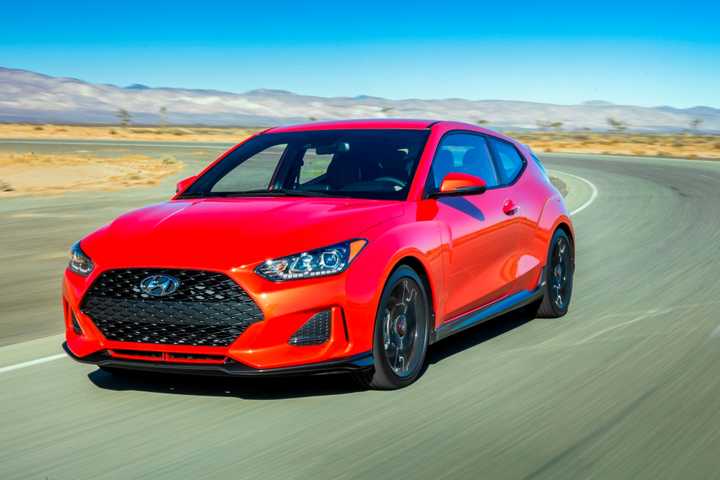We may now associate Hyundai’s performance expertise with its N division and, by extension, its involvement in different types of racing series, like the WRC or Touring Car Racing through IMSA, but all of that is relatively new. For the longest time, the South Korean automaker was actually more of a cheap way to get folks into a new car with a decent warranty. Performance was never really its thing.


- Base Trim Engine
-
1.6L Inline-4 Gas
- Base Trim Transmission
-
6-Speed Manual
- Base Trim Drivetrain
-
Front-Wheel Drive
- Base Trim Horsepower
-
132 hp
- Base Trim Torque
-
120 lb-ft @ 4850 rpm
- Fuel Economy
-
27/35 MPG
- Make
-
Hyundai
- Model
-
Veloster
- Segment
-
Compact Hatchback
Unlike American, German, British, and even Japanese automakers, Hyundai‘s racing heritage is actually pretty recent. It doesn’t have several decades of experience at famed racing events like LeMans or Formula 1. Nor has it ever sold a flagship sports car. Forget the notion of a supercar.
The N division kind of came out of nowhere, actually, mostly thanks to the help of outsiders like Albert Biermann from BMW, who helped spearhead the project after his hands-on experience in the M division. But before any of that happened, Hyundai was testing the waters with a few coupes, hatchbacks, and sedans to see if it had a chance on the performance side of things. One model in particular got the ball rolling for what we take for granted today.
To provide the most accurate and up-to-date information, this article uses data sourced from various trusted sources and the manufacturer, as well as the author’s personal experience.
Hyundai’s Performance Gestation Was Different From Other Automakers
Sure, we could say that Hyundai’s first “sports car” was the SCoupe, sold here in the early 1990s, but it really was with the Tiburon, that weird-looking, curvaceous sports coupe, that Hyundai started cutting its teeth on performance. Well, sort of.
While the first-generation car wasn’t all too competitive in its respective space, especially against what the Japanese were selling at the time (think Honda Prelude, Toyota Celica, and Acura Integra), the second-generation car didn’t look too bad and offered decent V-6 power in a crowd of either turbocharged or naturally-aspirated four-cylinders. The second-generation Tiburon proved that Hyundai could, in fact, build a solid sports car sold at a relatively attainable price point.
Then came the Veloster, an asymmetrical, four-door little hatchback (only one suicide door) that sort of reminded everyone of the Honda CR-X. The car was fine, until Hyundai introduced a pretty hot Turbo R-Spec model, complete with a manual transmission or, if you preferred, a dual-clutch automatic.
The Veloster Turbo was nowhere near as polished as, say, a Honda Civic Si, nor did it come with the same sort of refinement as a Golf GTI. But the effort was there. It was weird, fast, and fun enough to be taken (kind of) seriously by enthusiasts. The car also kick-started bold, new products at Hyundai, vehicles that dared to think outside the box. It also served as a turning point for Hyundai’s more focused performance efforts.
The Veloster Rally Edition Was The Start Of Serious Performance At Hyundai
Which brings me to the Rally Edition. Built at only 1,200 units for the 2016 model year, the Rally Edition tried to push the Veloster’s performance envelope a tad further by adding a set of aftermarket components. It was also a way to tell enthusiasts and the tuner crowd that Hyundai actually cared. In many ways, it was a very similar strategy to Mazda’s Mazdaspeed models in the early 2000s.
The bolt-on parts included a set of model-specific 18-inch lightweight RAYS wheels (five points lighter for each wheel), wrapped around tires that were 10 mm wider. There was also a rather neat matte blue paint job, which was exclusive to that car, as well as fake carbon fiber body accents. It all made the car look boy-racer-ish. The Rally was then equipped with a set of performance dampers, stiffer springs, larger stabilizer bars, and a B&M short-throw shifter. Because why not? The Veloster Rally Edition also came solely with a six-speed manual transmission.
Hyundai Veloster Rally Edition Delivers Rowdy Road Appeal
Output from the turbocharged 1.6-liter four-cylinder was the same as the R-Spec Turbo model: 201 horsepower and 195 pound-feet of torque, but the car’s interior had neat Turbo lettering and blue accents to match its cool paint job. The car was also equipped with a Dimension eight-speaker sound system with a trunk-mounted subwoofer. It was a true tuner special! Other features included:
- Bluetooth
- Seven-inch touchscreen display
- Leather upholstery
- GPS
- HD radio
- Apple Siri
When I reviewed the car, I really liked the total package, and I said that, finally, Hyundai had a true contender in its lineup to take on cars like the Golf GTI, or even the Ford Fiesta ST at the time. There wasn’t much in terms of steering feel, and the car’s chassis still needed work. The open differential also sort of ruined the fun when applying full power. It was definitely not the precise, well-oiled machine Honda, VW, or Ford were offering back then.
And you do feel that power behind the wheel. There’s a solid push of boost delivered down low, followed by a linear and steady delivery all the way to redline.
But the engine felt strong, rowdy, and was loaded with low-end torque. It also sounded pretty cool. The manual transmission felt slick and precise. And the entire car looked pretty rad with its weird third door arrangement.
2016 Hyundai Veloster Rally Edition Performance Specs
|
Engine |
1.6-Liter Turbocharged 4-Cylinder |
|
Horsepower |
201 |
|
Torque |
195 Lb.-Ft. |
|
Transmission |
6-Speed Manual or 7-Speed Auto |
|
Driveline |
FWD |
|
0-60 MPH |
6.7 Seconds (Car and Driver) |
|
Top Speed |
140 MPH (Car and Driver) |
I remember people flocking to it, asking me what it was. Looking back at it, almost a decade later, the Veloster Rally Edition already feels like a future classic for being so unique and rare.
Veloster Was Hyundai’s Test Bed For The N Division
Only two years later, Hyundai introduced the Veloster N, a car that not only marked the first-ever, true high-performance Hyundai, but also launched the N division that we know today. In many ways, the Veloster N was an evolution of the Rally Edition, except it was developed from the get-go as a much more capable machine. Based on the second-generation Veloster, it came with a considerably stiffer chassis, a limited-slip differential, and a much more potent, turbocharged 2.0-liter four-cylinder engine.
When I drove it, I couldn’t help but remember the rowdy little Rally Edition from a few years prior. And each time I drive one of Hyundai’s current N cars, it’s always the Rally that comes to mind.
The Veloster Hot Hatch Helped Hyundai Find Its Way
In many ways, the Veloster Rally Edition was a hinge moment in Hyundai’s performance gestation. Before that car, Hyundai was firing in all directions, looking for a true identity in a quest to be taken seriously by enthusiasts. Today, Hyundai’s N division has become a force to be reckoned with in the performance space. We owe it all to a weird little four-door hatchback with aftermarket bolt-on parts.








